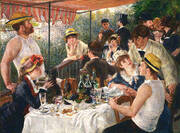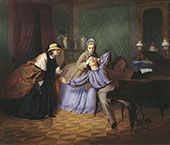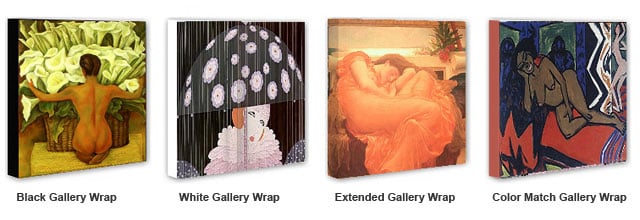The Luncheon of the Boating Party 1881 By Pierre Auguste Renoir
Renoir Luncheon of the Boating Party
Painted in 1881, Pierre Auguste Renoir’s Luncheon of the Boating Party is one of the crowning glories of Impressionist paintings. Described by Duncan Phillips, founder of the Phillips Collection, as “one of the greatest paintings in the world,” it remains one of the most visited and discussed artworks of all time.
Created for the 7th Impressionist Exhibition held in 1882, Renoir painted this epic oil on canvas painting to cement his reputation as a rising Impressionist artist. The painting was awarded “Best in Show” by three independent art critics and immediately purchased by Paul Durand-Ruel, the avant-garde Parisian art dealer, for $125,000. Pierre Auguste Renoir's famous painting quickly assumed legendary status.
Why did Renoir paint The Luncheon of the Boating Party?
Luncheon of the Boating Party is celebrated amongst famous Renoir paintings for its technical proficiency and vivid storytelling. His famous painting focuses on flickering, shifting light depicted with fleeting, fluid brushstrokes. Light streams in from the balcony opening, reflected particularly from the white shirts and rumpled tablecloths. Rather than carefully delineated outlines, the painting relies on contrasts of color and shape to build a scene full of interest and movement. Renoir's oil painting shows a group of friends socializing on the Maison Fournaise restaurant balcony. Scenically located along the river Seine in the suburbs of western Paris, the restaurant is still a popular haunt.
Who are the people in Renoir's Impressionist Painting?
All the figures in The Luncheon of the Boating Party are identifiable with reasonable certainty. They are mostly friends of the artist.
- The individuals on the immediate right of the composition consist of Angèle, one of Renoir’s long-standing muses, and the journalist Maggiolo.
- The painter Gustave Caillebotte mischievously sits backward on his chair. Caillebotte gazes across the table at Aline Chariot, a woman playing with her small dog. Aline Charigot and Renoir later married.
- The muscular Alphonse Fournaise Jr., the proprietor’s son, leans against the railings, staring back into the painting. This draws the viewer’s gaze toward the remaining figures.
- The background figures include the cavalry officer Raoul Barbier, facing away from the viewer, and the banker and art editor Charles Ephrussi, wearing a top hat.
- Jeanne Samary, a touring actress with the Comédie Française, appears in the upper-right-hand corner. Jean Samary is the subject of several portrait paintings by Renoir.
Despite the long scholarship on their exact identities, the specifics of Renoir’s sitters are not integral to the meaning of the paintings. Renoir aimed to immortalize the sitters as representatives of contemporary society rather than individual character sketches.
Famous Renoir Paintings
Amongst Renoir's artwork, Luncheon of the Boating Party is particularly hard to define in terms of genre. Some class it as an impressionist landscape painting. Others argue it is best appreciated as a modern Genre painting or a simple group portrait.
Buy famous art reproductions of Renoir's Boating Party. Famous oil paintings are 100% hand-painted. Impressionist replica paintings are for sale in many sizes and make a great addition to any home or office.
We offer a 100% money back guarantee or replacement service. If for any reason you are dissatisfied with your painting please contact us within 7 days of receipt, advising the reason you are unhappy and we will provide you with all the information you need for its return or replacement.
We ship free to anywhere in the world via FedEx or DHL expedited service with online tracking.
Your painting will be shipped rolled in strong plastic tubing, ready for stretching and/or framing locally. This is the conventional method of transporting hand-painted oil on canvas. Learn more about how your painting is shipped.
We are able to offer a framing service intercontinental U.S. Please contact us if you would like a quotation. Alternatively, should you prefer, we can recommend a framer in your area.
Notes About Your Painting
Please note that replica oil paintings are finished with an additional 10cm (4") of extra canvas on all sides, allowing ample surplus canvas for stretching and framing.
Cannot Find What You Are Looking For?
Reproduction Gallery Information
Customer Service
(Send Us A Message)
Tel: (503) 937 2010
Fax: (503) 937 2011








